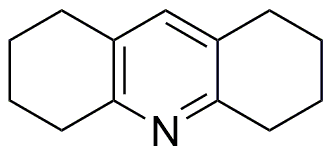1,2,3,4,5,6,7,8-Octahydroacridine is widely utilized in research focused on:
- Pharmaceutical Development: This compound serves as a building block in the synthesis of various pharmaceuticals, particularly in creating analgesics and anti-inflammatory agents. Its unique structure offers potential for developing new medications with improved efficacy.
- Organic Synthesis: It is a versatile intermediate in organic chemistry, facilitating the creation of complex molecules. Researchers often use it to explore new synthetic pathways, making it valuable in academic and industrial laboratories.
- Material Science: The compound is explored for its potential use in developing advanced materials, such as polymers and coatings. Its properties can enhance the durability and performance of these materials in various applications.
- Biological Research: Researchers investigate its effects on biological systems, particularly in neuropharmacology. It may help in understanding neurological disorders and developing targeted therapies.
- Environmental Applications: The compound is being studied for its potential role in environmental remediation processes, particularly in the degradation of pollutants, showcasing its versatility beyond traditional applications.
General Information
Properties
Safety and Regulations
Applications
1,2,3,4,5,6,7,8-Octahydroacridine is widely utilized in research focused on:
- Pharmaceutical Development: This compound serves as a building block in the synthesis of various pharmaceuticals, particularly in creating analgesics and anti-inflammatory agents. Its unique structure offers potential for developing new medications with improved efficacy.
- Organic Synthesis: It is a versatile intermediate in organic chemistry, facilitating the creation of complex molecules. Researchers often use it to explore new synthetic pathways, making it valuable in academic and industrial laboratories.
- Material Science: The compound is explored for its potential use in developing advanced materials, such as polymers and coatings. Its properties can enhance the durability and performance of these materials in various applications.
- Biological Research: Researchers investigate its effects on biological systems, particularly in neuropharmacology. It may help in understanding neurological disorders and developing targeted therapies.
- Environmental Applications: The compound is being studied for its potential role in environmental remediation processes, particularly in the degradation of pollutants, showcasing its versatility beyond traditional applications.
Documents
Safety Data Sheets (SDS)
The SDS provides comprehensive safety information on handling, storage, and disposal of the product.
Product Specification (PS)
The PS provides a comprehensive breakdown of the product’s properties, including chemical composition, physical state, purity, and storage requirements. It also details acceptable quality ranges and the product's intended applications.
Certificates of Analysis (COA)
Search for Certificates of Analysis (COA) by entering the products Lot Number. Lot and Batch Numbers can be found on a product’s label following the words ‘Lot’ or ‘Batch’.
Numéro de catalogue
Numéro de lot/série
Certificates Of Origin (COO)
This COO confirms the country where the product was manufactured, and also details the materials and components used in it and whether it is derived from natural, synthetic, or other specific sources. This certificate may be required for customs, trade, and regulatory compliance.
Numéro de catalogue
Numéro de lot/série
Safety Data Sheets (SDS)
The SDS provides comprehensive safety information on handling, storage, and disposal of the product.
DownloadProduct Specification (PS)
The PS provides a comprehensive breakdown of the product’s properties, including chemical composition, physical state, purity, and storage requirements. It also details acceptable quality ranges and the product's intended applications.
DownloadCertificates of Analysis (COA)
Search for Certificates of Analysis (COA) by entering the products Lot Number. Lot and Batch Numbers can be found on a product’s label following the words ‘Lot’ or ‘Batch’.
Numéro de catalogue
Numéro de lot/série
Certificates Of Origin (COO)
This COO confirms the country where the product was manufactured, and also details the materials and components used in it and whether it is derived from natural, synthetic, or other specific sources. This certificate may be required for customs, trade, and regulatory compliance.


